- The challenges involved in getting EV chargers hooked up to the grid are well-known to Charged readers. Various off-grid solutions are available, but the best approach may be a flexible one—using some combination of onsite generation, battery storage and grid power, according to what’s available and what’s needed for the application.
- Paired Power offers a pair of microgrid-based products. The PairTree is an off-grid EV charger with solar, storage and two Level 2 EV chargers that can be set up in a day. PairFleet is a scalable system that can serve fleets of any size, and can be set up in a few days.
- Paired Power’s microgrid approach relies on in-depth consultation with customers before the first product gets ordered. How much power is available at the site? How much power will you need, and on what schedule? These factors determine the best mix of solar, storage and grid power for a particular project.
Build your own microgrid in a few days: Q&A with Paired Power CEO Tom McCalmont
As fleet operators know (or soon find out), deploying EV charging infrastructure involves much more than buying some chargers and running some conduit. Obtaining adequate power at a site is often a challenge, and it almost always takes a long time. At sites with limited or no grid power, plugging EV chargers into the grid may be impossible—but that doesn’t mean you can’t get your EVs charged.
At Charged, we’ve spoken with a lot of companies that are offering solutions and/or workarounds for these problems—these usually involve some mix of onsite generation (almost always PV solar), battery buffering or storage, and charging management. These solutions go by the collective name of microgrids.
Microgrids offer other advantages: partially decoupling from the grid can help fleet operators avoid expensive utility demand charges, ensure that they’re charging with mostly green energy, and offer a backup power source in case of a power outage.
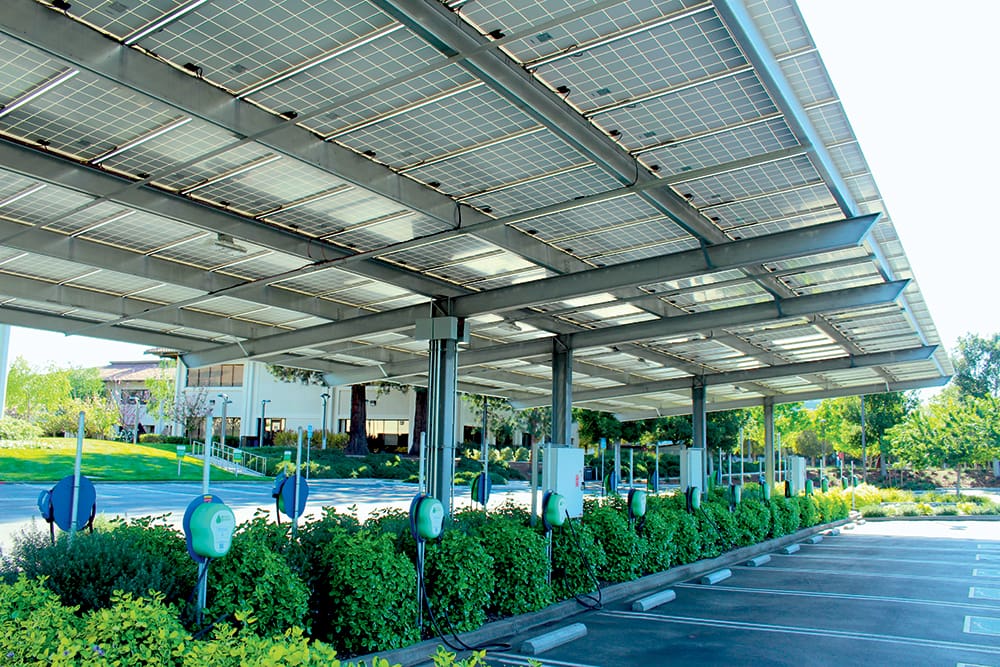
Paired Power offers a pair of microgrid-based products, each addressing a different market. PairTree is an off-grid EV charger featuring a pop-up solar canopy, a 42.4 kWh energy storage system, and one or two Level 2 5.3 kW EV chargers. It’s designed to be set up in just one day. PairFleet is a larger, scalable system that offers battery capacity from 5 to 85 kWh and Level 2 charging at up to 15.3 kW. It can serve fleets of just about any size, and can be set up in a few days.
To learn more about microgrid-based charging, Charged spoke with Paired Power CEO Tom McCalmont.
Charged: What’s the difference between PairTree and PairFleet?
Tom McCalmont: PairTree is the product we’ve been selling for about a year, which is a pop-up solar canopy that can be a fully off-grid power source, or can be grid-connected. It’s really a microgrid, and has a small footprint.
Our PairFleet scales that up to a much bigger system, so it can include more solar, more storage, more EV chargers, but it works on the same basic concept of a microgrid.
We think of it as an EV charger first, but it’s not necessarily only an EV charger. Like any microgrid, it has the capability of being a power source, so you could use it, for example, for emergency power, or for V2B applications.
Charged: We’ve spoken in the past with a couple of companies that do off-grid solar-powered EV chargers. Perhaps you’re familiar with Beam. What differentiates your product from theirs?
Tom McCalmont: Beam’s product is more comparable to our PairTree, but the differences are many. One is that they have a tracker mechanism, and trackers suffer from a lot of disadvantages. They were common 15 years ago when solar was expensive, but now that solar panels are inexpensive, the maintenance for having motors that move the panels is not a particularly good idea—for a lot of systems that you see in the field, the motors are frozen in a certain position, either because they failed, or they haven’t been maintained and lubricated.
Solar trackers were common when solar was expensive, but now that solar panels are inexpensive, the maintenance for the motors that move the panels is not a good idea. We took a different approach, using bifacial panels to get similar energy yields.
We took a different approach. We said, “Let’s try to get the energy yields that you can get from a tracker from bifacial panels.” Bifacial panels capture reflected light from the pavement, in addition to light on the top surface of the panels. No moving parts, no motors, no maintenance, but you get about the same energy yield, so our PairTree structure actually has a little more energy yield than Beam’s structure does, but without the maintenance burden.
The other thing that I think a lot of people miss is that off-grid works in some applications—places like parks and beaches where you don’t have any grid at all—but there are a lot more places where you have a little bit of grid power, for example a parking lot that has a lighting circuit. A lot of parking lots have been converted to LED lights, and during that conversion, the electricity draw on that circuit was decreased, because the LEDs use less current, so you have a little excess capacity in that circuit, and if you tie into that, now you can cover things like cloudy days or rainy days much better.
If you have a system that’s completely off-grid, you have a bunch of rainy days, and your battery gets depleted, well, now you can’t charge any cars. We think that’s a disadvantage to the off-grid approach that we’ve overcome—we like situations where we can tie into a little bit of grid.
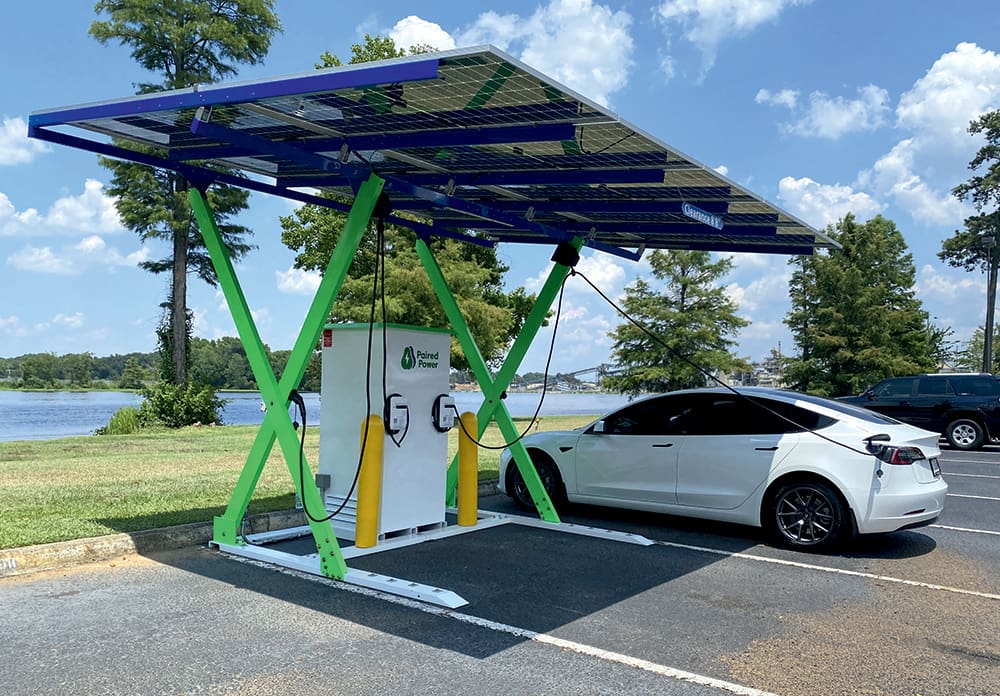
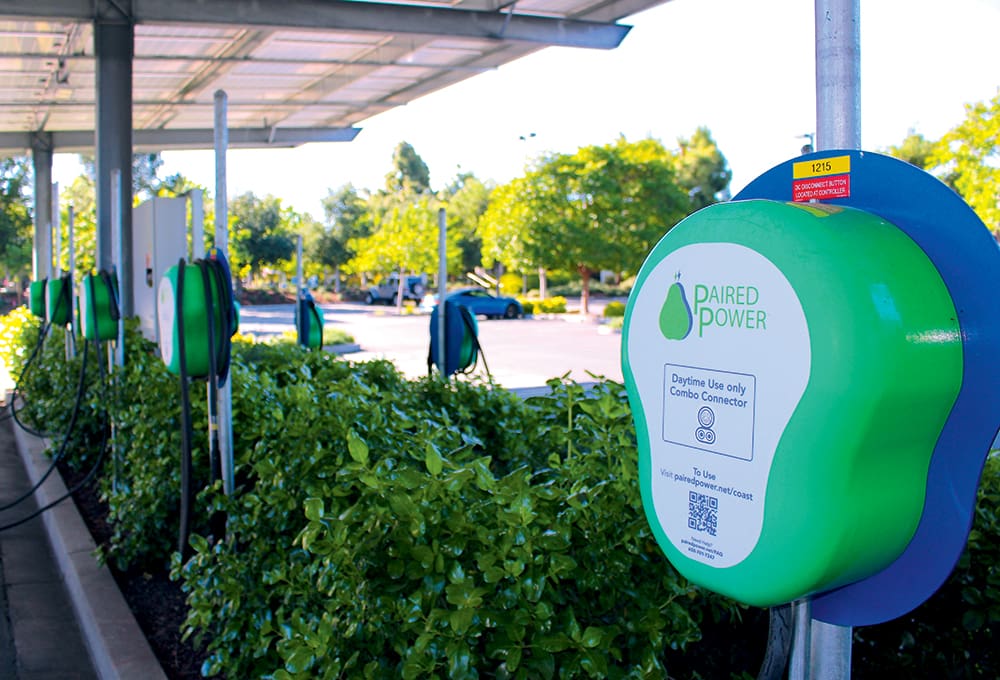
The other thing we think is important is that you need control of the chargers, so you have control of the energy flows—from the sun, from the battery, from the grid, to the load. You have to manage all of that carefully, and you have to have intimate control of the charger to be able to do a good job of that. We can use third-party chargers, but we prefer to use our own, because it gives us tighter control of the energy flows.
We have a relationship with EV Connect, and with LITEON, so we can use standard commercial chargers in addition to our own. But there’s an advantage in terms of management. We’ve invested a lot in the software, too. We have a very comprehensive software stack for energy management, and that is really, in my view, critical to a successful microgrid. Our in-house developed software allows control of all the elements in the microgrid, so I can configure it for control of solar, storage, the grid and the chargers—all four—and decide how I want to allocate that energy flow.
There are different ways you might choose to charge a number of vehicles, depending on the available energy that you have in the system. One method is by priority: “I want to give the most current that I can give to the vehicles that are present.” Another is what we call shared power: “I want to share the available power I have equally across all the vehicles that are present.”
Customers can also do things like set their own priorities. Maybe certain classes of vehicles need more during the day. Maybe they’re used for emergency services, or you want to prioritize people who live in apartment buildings, because they don’t have access to home charging, versus people who do have access to home charging. Having an energy management system allows us to have that kind of flexibility, that kind of control to work with the site host to deliver exactly the charging scenarios that their vehicle population requires.
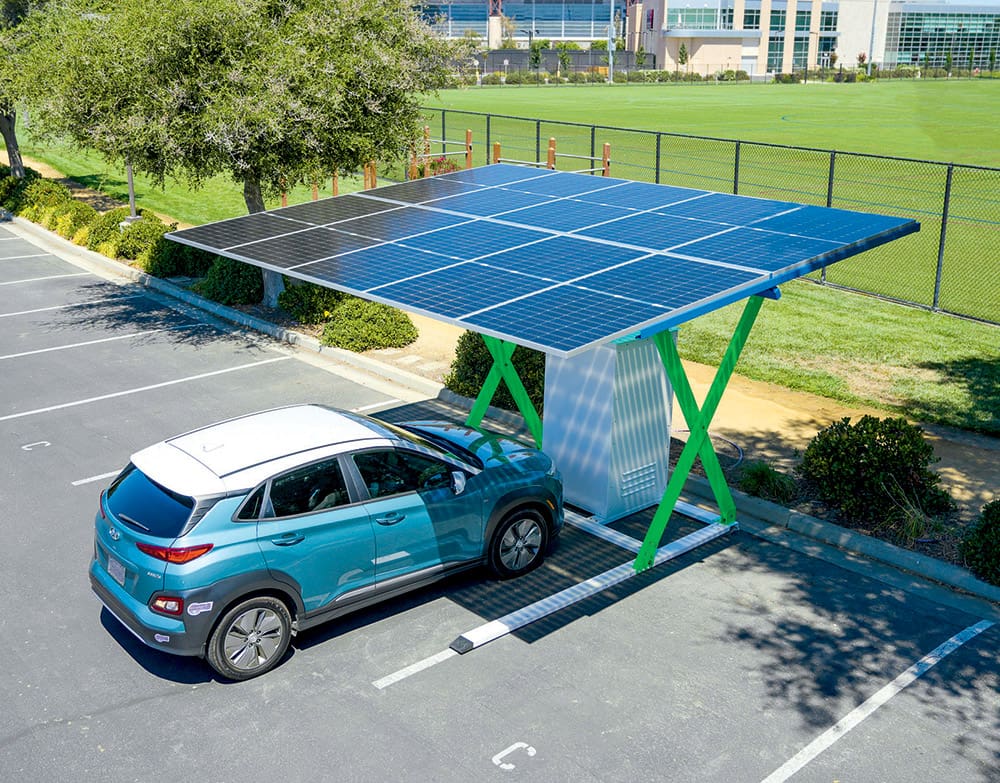
Charged: Tell me about the chargers. You manufacture them?
Tom McCalmont: We do. It’s our own design, and we make it here in the United States. When we started the company, because I came out of the solar industry, in our early life our vision was around DC charging, and our first product delivered direct DC charging from solar to the vehicle. We patented that, and we still sell that type of system today.
However, as you know, standards in the DC world are more problematic, which is one reason we’ve taken a little bit of a step back from that. There are many DC interfaces: there’s CHAdeMO, there’s Tesla, there’s CCS, there are all these different DC variations, so trying to please everyone becomes harder. When we realized that, we developed our AC charger, and it couples nicely with batteries. But we still have the DC technology. We did V2G way before anybody else, so we know there’s potential in making use of that at some point. As V2X capabilities become more available in vehicles, it’ll allow us to use that technology we’ve already developed.
Charged: Tell us more about your new product, PairFleet.
Tom McCalmont: PairFleet takes the same basic system, the same components as PairTree, but allows the customer to scale that up to a much larger scenario. Typically, that larger solar array will be a traditional solar canopy, not a pop-up canopy, with solar panels on a steel rack, potentially more storage, and supporting many more vehicles. We call it PairFleet, but, for us, a fleet is any collection of EVs that need simultaneous charging—for example, daytime workplace charging for employee vehicles is really a fleet, as is a collection of service vehicles that are charged at night.
In our energy management system, we allow you to define your fleet, so for example you can say, “I have 100 vehicles, 50 of them are Teslas, 30 of them are Chevy Volts, and 10 of them are E-Transit vans,” and you can define the different levels of range required by the different vehicle categories. How many miles do they drive in a day? What do they need in a day in terms of replenishment? What hours during the day will they be available to charge? We have a whole fleet definition component to our software.
We analyze a customer’s energy needs. How much do you need, and where are you going to get it? How much solar, how much grid, how much battery storage? All those capabilities are encompassed in PairFleet, our offering for large commercial customers.
Then based on that, we can analyze a customer’s energy needs. What do you need in terms of energy, and where are you going to get that energy? How much solar do you need? Do you have an available grid connection? If so, what capacity is it? Is it 3-phase or single-phase? What voltage is available? How many amps? Is there a benefit to having some battery storage? For example, maybe you have a time-of-use rate schedule—power is cheaper at night, so you can charge the battery storage at night, and then deliver that energy in the daytime.
All of those capabilities are encompassed in PairFleet. We’re selling that to large commercial customers, who have a fleet charging problem. The existing electric grid is not big enough to fully electrify transportation. As we electrify more and more transportation, there simply is not enough grid power to meet the need, and so microgrids that are augmented by solar are going to be crucial to meeting that demand.
Charged: With PairFleet, are there minimum and maximum numbers of vehicles?
Tom McCalmont: With our design software, we can basically accommodate any size. We have a separate program we use for analysis. We call that Pairiscope, and we use it to analyze, “How many vehicles are you trying to charge? How many miles do you need? When do you need the miles? What are the miles per kilowatt-hour each vehicle requires?” Then based on those inputs, “How much solar do I need, or have space for? How much battery do I need, or have? How much grid power do I need or have available?” We put all that together to build the solution.

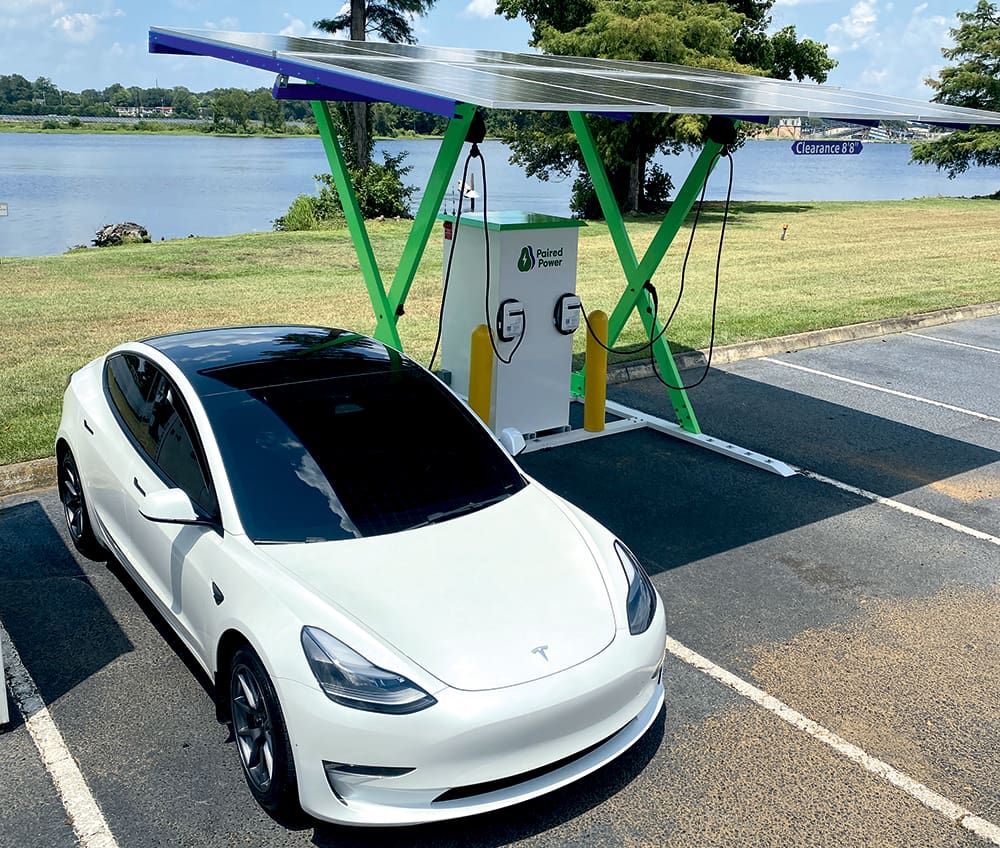
Charged: So, when you have a potential customer, it sounds like you have to do a good bit of research and consultation before you make a proposal.
Tom McCalmont: Yeah. We try to analyze their specific situation. We have all the components. We know we have solutions that are well-integrated, that will meet their needs, and they’re also very scalable, so we can design a solution that is perfect for them.
Charged: I’ve heard from a number of people that the problem is often not so much not having enough power, but not having the right kind of power. For example, many DC chargers require 480-volt 3-phase power, which isn’t available everywhere. But with your product, it sounds like that’s not much of an issue.
Tom McCalmont: That’s right. We select the inverter or transformer combination to accommodate whatever grid power happens to be available—it could be 480 3-phase, 208 3-phase, 240 volt. Any of those, we can accommodate.
We recognize there’s a big market for [fast charging], but we think the more prevalent form of charging is going to be topping up wherever you might be—retail, workplace, school, home.
However, we’re not so focused on DC fast charging. We recognize there’s a big market for that, but we think the more prevalent form of charging is going to be daily range replenishment, just topping up wherever you might be—retail, workplace, school, home. If you look at the EV market, overall, much more charging is done in those kinds of facilities than is done at DC fast chargers.
Charged: What stage would you say Paired Power is at right now as a company?
Tom McCalmont: I still think of us as a startup, but we’re a little bit older than many startup companies. The first target market we addressed was workplace charging. Well, during the pandemic, nobody was at their workplace anymore, so that was when we developed PairTree— we said, “This is a perfect opportunity to innovate and develop something completely new.”
Then as that became finished, we realized, “We really have a microgrid here, let’s take this up to a much bigger level.” That’s what we’ve now done with PairFleet, because the problem of limited grid capacity and large numbers of vehicles that need charging is really becoming pronounced now. We’re still self-funded. The founders have funded the company to date, but we are considering raising an A round now to really scale, and take the company to a larger size and ramp up production to meet our order book.
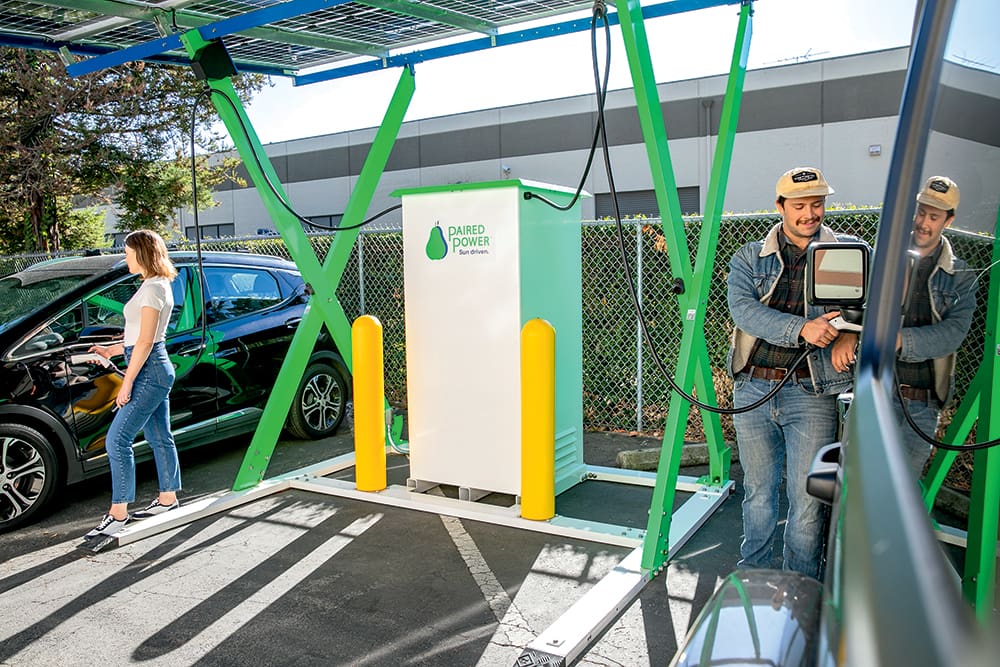
Charged: What can you tell me about some of your existing customers?
Tom McCalmont: They fall broadly into a few different categories. Certainly, agriculture is one, and PairTree has had a lot of interest in different agricultural applications. The grid connection is typically horrible on a farm. Most farms are at the end of a distribution line, so having a solution that’s either off-grid or microgrid can make use of the existing grid capacity that’s available there. We’ve seen interest at wineries. We have a system at Gallo Farms that’s used for their cheese factory operation.
We have several systems for large commercial customers. A lot of those were built a few years ago using our first product, direct solar to vehicle, so these are big commercial companies—Intuit, for example. Some of those customers are now considering upgrading to our PairFleet solution. Some of these commercial campuses have maybe 3,000 employees, with as many as 1,000 of them driving EVs now, and so they’re trying to figure out, “How do I get enough infrastructure in place to help support my employees, and support cleaner commutes?” It’s difficult to do that with grid power alone.
We have done some data centers. Data centers use so much energy, they want something that’s solar-augmented, so they can provide EV charging without having any impact on their load.
We’re talking to cities. We actually have a bunch of PairTrees being installed this summer. The city of Davis, California is putting two in. We just sold a system in South Carolina to a commercial product company. We have a system running for the Delaware National Guard—that’s a military installation. There are several other cities pending as well. Our home city of Campbell has purchased one, and that’ll be installed in a few weeks. We have a local university that’s bought some PairTrees that’ll be installed this summer. They’re using those to charge service vehicles, like golf carts for campus use, rather than cars.
This article first appeared in Issue 69: July-September 2024 – Subscribe now.
